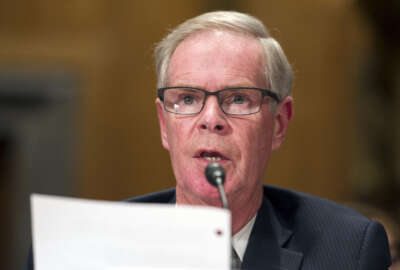
DATA Act advocates reflect on three years of planning, partnerships, predictions for future spending reports
Open government advocates, industry, and agency officials are eagerly looking toward the May 9 implementation date for standardized federal spending information.
The Treasury Department has been publishing financial data since the 18th century, and in less than two weeks it will reach not only a new milestone, but a springboard to the next era of information sharing.
May 9 is the implementation deadline for the Digital Accountability and Transparency Act, and for Christina Ho, Treasury’s deputy assistant secretary for accounting policy and financial transparency, it’s a day to get excited about.
“If data is the new oil, we’ve been doing the hard work of drilling in the past three years, and now we want to really unleash it and have more people use it and linking it,” Ho said April 27, during the two-day DATA Act Hackathon in Washington, D.C. “I view publishing the data just as the beginning. That’s why the [DATA Act Information Model Schema] is very significant, because it’s the first financial data standard that’s industry-based and extensible. Linking all these data sets is going to eventually help us solve more problems and understand more solutions. So this is just the beginning. Treasury has been in the business of publishing financial data for a very long time, since 1789. Because of the technology and the resources that are going to be available and all the collaboration opportunity, we’re going to have greater insight [into how] these data now can be used.”
The hackathon was hosted by the Data Coalition and Booz Allen Hamilton, and included not only Ho’s panel, but a roughly 30-hour competition where about 15 teams of industry and agencies created apps that draw on the federal spending information that will be loaded into the new version of USASpending.gov. The teams are working with data — about 100,000 spending reports — submitted in one unified data set from 30 large and small agencies. The site is in the prototype phase and in September it will be moved to the current USASpending website.
The data behind the site will be available on the site’s API.
Matt Lira, special assistant to the president for innovation policy and initiatives, said what’s inspiring for him is to see how people from a variety of areas have come together not only for the hackaton but for the DATA Act implementation as a whole.
“We’ve seen disruptors from outside government, disruptors inside government, we’ve seen experts and issue experts and policy experts, people who haven’t always worked together inside the administration of government itself, working together to deliver a fantastic product,” Lira said. “Teams from 18F, USDS, Treasury, OMB, private industry, coming together and saying ‘how can we make this work?’ I think it’s a model for how as we look at the broader modernization of the federal government, the opportunity that presents itself. If we can work together across different coalitions and different perspectives, and we can work together across different levels of expertise, we can truly modernize the American federal government: deliver more efficient services, more effectively at a higher quality for all the American people.”
Impact and value
Before the roughly two dozen teams got down to business, the event’s panel discussion looked back at the start of the DATA Act, and what its implementation means for government and the private sector.
The DATA Act was signed into law three years ago, and since that time, Treasury and the Office of Management and Budget have worked to help agencies prepare for the rollout of their standardized federal information.
“It’s truly exciting to see it now coming together,” Ho said. “One significant factor that we have in implementing the DATA Act is that we have demonstrated that the government can work differently, at scale. Innovation does have its value and this is actually something that I have been doing that’s the most important thing I’ve done in my 24-year career in terms of its impact and value.”
Ho’s team initially faced limited resources and what would eventually be a lot of data. Ho said they chose an open source, agile approach and user-centered design.
“All of it has been showing us today that that is really worth doing, because the result is significantly better,” Ho said.
What the DATA Act implementation also shows, said Kristen Honey, senior policy analyst at OMB, is that it’s possible to launch products that aren’t “fully baked” and end up delivering something that’s a higher quality than you would have delivered from behind closed doors.
“That’s completely new, and a radical culture change,” Honey said.
Honey said the DATA Act is also not just about getting data out in the open, it’s about better management of data.
“Knowing what you have, doing your cybersecurity properly, doing your privacy properly, if you think of data on a continuum and you do all that properly, then ‘open’ should be the default and naturally fall out,” Honey said. “So we’re not separating open data from the rest of the data life cycle or data ecosystem, but it really was an opportunity to say let’s do our government data management better. Come up with some shared standards and meta schema and make that publicly available, keeping the American citizens and users first and foremost. So they can have one stop shopping and go to one place to find data no matter what agency provides it, whether it’s about space data, ocean data, health data, it should be easy to discover, machine readable and open to taxpayers since in reality, you’ve already paid for it. It should be America’s data.”
What taxpayers can get out of their data is a range of information, the panelists said.
While agency heads and media will be interested in the information, the standardized data will also make it possible to tell a more complete story about the country.
The government gives out a lot of loans, Ho said, and that loan information can be linked with geographic information to study unemployment data.
You can also compare state and local funding in one place, and if the schema is extended to other users like foreign governments, that can tell a story about foreign aid.
“We’re taking the first step to tell people how much we’ve been spending on what,” Ho said. “Ultimately the question is going to be what did we get out of it.”
Copyright © 2024 Federal News Network. All rights reserved. This website is not intended for users located within the European Economic Area.
Related Stories

Sen. Warner urges new agency leadership to ‘prioritize’ DATA Act implementation




